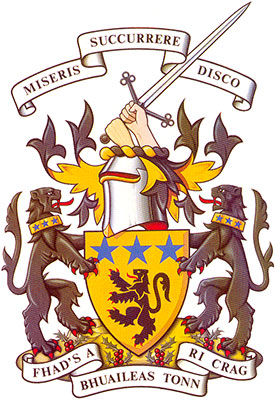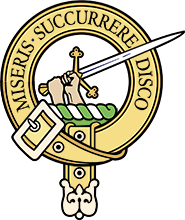Symbols of Clan MacMillan.
Scottish clans are replete with symbols, today's proud clansman bedecked in tartan and clan badges. However, these contemporary symbols were not commonly worn when Highland clans existed in the traditional sense, that is before "the '45". While Highlanders certainly wore a kind of tartan, uniform clan tartans representative of specific clans did not generally come into existence until the nineteenth century. Read more about Clan MacMillan's tartans.
Holly, the plant badge of Clan MacMillan.

Well before badges and tartan identified a Highland clansman's affiliation, the plant badge was the only identifying emblem, sprigs affixed to the bonnet. Worn in battle, these were called suaicheantas in Gaelic and believed to provide magical protection to the wearer. By necessity, they had to be of varieties that did not shed their leaves, otherwise they would not serve in the winter. For Clan MacMillan this badge is holly. Other clans sharing the holly badge are Drummond, MacInnes, MacLean and Matheson, this being coincidental and not connoting any other relationship with Clan MacMillan.
Clan motto: "Miseris Succurrere Disco".
Clan MacMillan's motto is Miseris Succurrere Disco (Latin for "I learn to succour the distressed"). It derives from The Aeneid by Virgil in which the Carthagian queen Dido says"Non ignara mali, miseris succurrere disco". This translates as "Not myself being unacquainted with difficulty, I learn to succour the distressed".
Who first employed it in this context and when is not known. The earliest record of it being applied in reference to the Clan is the signet ring of Rev. John McMillan of Balmaghie (c.1699 - 1753). It accompanies the coat of arms matriculated in 1742.
Clan MacMillan's badge derives from the Chief's coat of arms.

MacMillan Chief's Coat of Arms The Chief's complete coat of arms, referred to as the "achievement" (pictured at left) is the standardized composite of a number of symbols of Clan MacMillan including the motto and holly plant badge. A central element in the Chief's coat of arms is the "crest", the two-handed sword or claymore (claidheamh-mor - "great sword" in Gaelic).
This sword was said to refer to the weapon with which Cormac mac Airbertach (the "Great Bishop", father of Gilchrist, progenitor of Clan MacMillan) "performed some signal achievement, being a means of his first advancement". The MacMillan sept name Leny also makes reference to this sword.

Only the Chief may wear or display his coat of arms. Clanspeople wishing to display their membership of the clan and adherence to the chief wear a "crest badge" (pictured at right) consisting of two elements of this coat of arms - the motto and the claymore, enclosed in a circular belt.
Other MacMillan heraldry.
Clan historian Graeme Mackenzie, MA has covered the subject of Clan MacMillan symbols in more depth in some of his books. Most recently he published Clan MacMillan, A New History. To procure the book see this PDF for more information.
